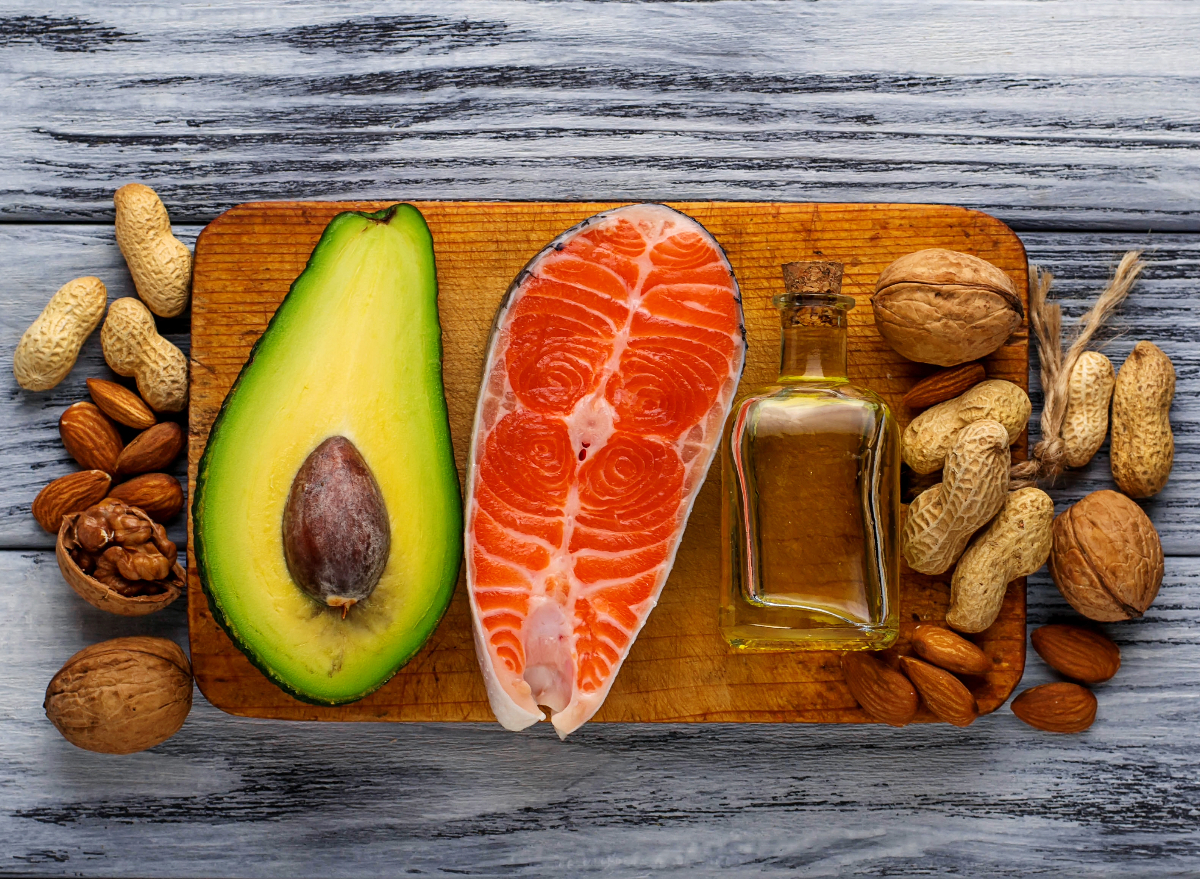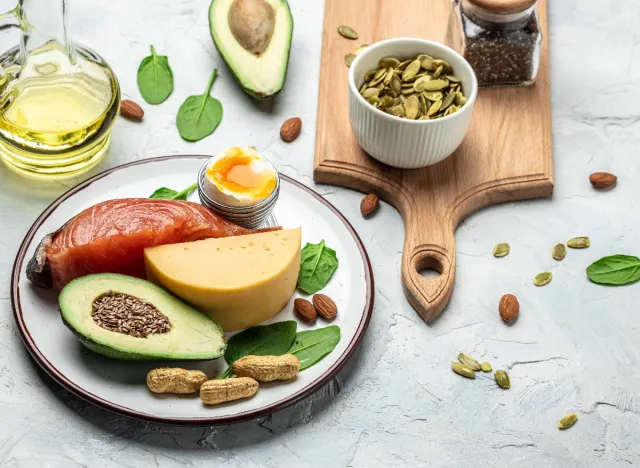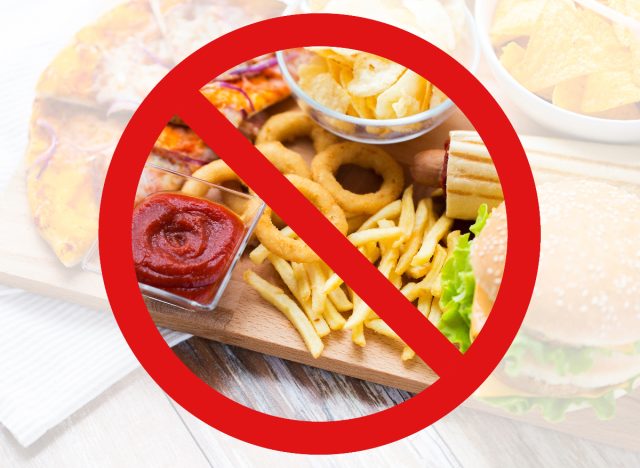The #1 Best Low-Fat Diet for Weight Loss

If you’ve been researching different diets for weight loss, you’ve likely come across suggestions for a low-fat diet. While there is not one right way to approach weight loss, low-fat diets have maintained popularity over the past several decades. Most people can successfully achieve weight loss with a variety of approaches, but limiting fat in your diet is one popular way to reduce the total number of calories you eat. Read on to learn the best low-fat diet for weight loss, along with tips for following this dietary approach. And when you’re finished, for more inspiration, be sure to check out the 10 Best Superfood Snacks to Strip Away Belly Fat.
What Is a Low-Fat Diet?

Although low-fat diets have been a weight loss approach for many years, there is no scientific definition for this approach. However, guidelines for this diet will suggest that you eat fewer than 30% of your total calories from fat. For example, if you eat 1,500 calories in a diet, fewer than 450 calories (or 50 grams) should come from fat.
To make this diet work for your health and weight loss goals even more, you should pay attention to the types of fat you eat. While all fats contain around nine calories per gram, the quality of these various fats is not created equally. Unsaturated fats are largely found in plant-based foods like avocado, nuts, seeds, and olive oil. This type of fat is thought to be more beneficial for your health, as it can improve blood cholesterol levels, promote heart health, and reduce inflammation. To achieve these benefits, the majority of the fat grams you eat should come from unsaturated sources.
The other main form of fat is saturated fat. This is generally found in animal-based sources, like butter, cream, red meat, and cheese. The American Heart Association (AHA) recommends eating no more than 6% of your total calories from saturated fat. This is because saturated fat may negatively impact your cholesterol levels and heart health. While following a low-fat diet, all grams of fat should be limited to fewer than 30% of your total calories, and you should keep a watchful eye on consuming minimal amounts of saturated fat within that budget.
Lastly, trans fats can be found in processed foods and are also considered to be an unhealthy form of fat. The AHA recommends reducing your intake of trans fats and limiting your intake of foods that contain partially hydrogenated vegetable oil that feature this nutrient.
Low-fat diets gained popularity because it is a dietary approach that can restrict your calorie intake. Each gram of fat contains nine calories, which is more than double what carbs and protein provide. By limiting your total intake of fat, you can more significantly reduce your calorie intake than if you just restricted carb and protein consumption. If you are able to scale back your calorie intake, and eat fewer calories than you burn in a day, this may help you reach your weight loss goals.
The Benefits of Low-Fat Diets for Weight Loss:
When you reduce the total grams of fat you eat in a day, you can reduce your total calorie intake. This can create an equation that is more favorable for weight loss. At the same time, a low-fat diet can reduce the amount of saturated fat you eat in a day, further aiding your health. While saturated and unsaturated fats both contain nine calories per gram, focusing your fat intake on plant-based sources of fat may have more benefits to your health. Additionally, while fat may be limited more than carbs and protein, eating 25% to 30% of your total calories from fat still allows a comfortable budget to be able to enjoy the fat-containing foods you love, while still achieving weight loss.
The Best Low-Fat Diet for Weight Loss:
When choosing a low-fat diet that works for your weight loss goals, there are several factors to keep in mind. Reducing calorie intake is a goal of this dietary approach, although there are other nutrients that may become less available with this practice. Here is a breakdown of low-fat diets, and which is the best.
Very Low-Fat Diet
This dietary approach takes fat restriction to another level, recommending you limit your daily fat intake to less than 10% of your total calories. While this can reduce your calorie intake, it can also reduce your consumption of omega-3 fats, other unsaturated fats, and vitamins found in foods rich in fat. Although there is research to suggest a very low-fat diet may possess cardiac benefits, other data suggests nutrient deficiencies may be a concern for some subgroups following a very low-fat diet. For these reasons, this may not be the best low-fat diet for most people.
High-Carb, Low-Fat Diet
While you reduce your total fat intake, you’ll have to increase protein and carbs in your diet to meet your energy needs. While carbs can be a source of important nutrients, like B vitamins and fiber, many carbs-dense foods are processed with added sodium and sugar. This makes them less ideal for weight loss. High-carbohydrate intake is considered to be more than 60% of your total calories. Research shows that meals high in carbohydrates can increase blood sugar and triglycerides, and decrease the good cholesterol in your blood. While this can be partly due to the carb sources, you may be better off reducing your total carb intake to promote health and weight loss.
Low-Fat, Moderate Carb and Protein Diet
In nutrition, extremes are usually not recommended. For example, a very low-fat diet may aid in weight loss and heart health, however, it could lead to nutrient deficiencies that have a ripple effect within the body. And, eating way too much carbs may also have some negative outcomes. Instead of eating on the extremes, a more moderate, balanced diet is usually the best. A low-fat diet (less than 30% of your total calories) with moderate amounts of carbs and protein, may aid in weight loss while also contributing to health parameters.
In fact, research noted that moderate carb intake between 50% to 55% of daily calorie intake was associated with decreased death rates than individuals who usually consumed high or low-carb meals. Additionally, a diet that contains moderate amounts of carbs can provide satiating fiber, which can aid in weight loss. Similarly, moderate amounts of protein could be beneficial for weight loss. One study found individuals who ate a moderate protein diet achieved more fat loss than those eating a high-carb diet. While this particular study calculated protein needs based on weight rather than a percentage of calories, it can be assumed that a moderate protein intake could fall between 20% to 35% of total calories. Based on this information, a low-fat, moderate carb and protein diet may be best for weight loss results and health outcomes.
Tips for Success on a Low-Fat Diet:

If you are new to a low-fat diet and trying to figure out how to improve your food intake, here are a few tips.
- Avoid fried foods. Chips, fries, fried meat, and pastries are just some examples of fried foods. This preparation can drastically increase the oil and fat grams in your diet, making it hard to meet the low-fat guidelines. Instead, choose preparations that use less oil, like baked, steamed, sautéed and roasted.
- Limit fatty meat. If you can see dense marbling in meat, like a steak, you are better off skipping it. These cuts are high in fat and saturated fat, making a low-fat diet hard to follow. Instead, stick with fish and poultry, and occasional lean cuts of red meat and pork.
- Find low-fat foods that are convenient. But watch out—many packaged foods are loaded with added fats, which can take away from your weight loss progress. If you need some inspiration, egglife egg white wraps are a great, convenient low-fat option. Because they are made of 95% egg whites, they contain one gram or less of fat. These tasty and versatile wraps are the perfect substitute for tortillas, packing five grams of protein and less than 35 calories to further promote weight loss and help you reach your goals.
Nutrient deficiency and inadequate intake of essential fats are the main concerns when following a low-fat diet. Because of this, it is important to stay vigilant of your fat sources and amounts while following this approach. Each meal should contain some form of fat to ensure intake throughout the day, and you may also consider an omega-3 supplement to ensure you consume enough of this essential nutrient. Incorporate small amounts of fat-containing foods throughout the day, like avocado at breakfast, olive oil on your salad, a small portion of nuts for snacks, and salmon rich in unsaturated fat for dinner. This example plan meets low-fat diet parameters while still allowing you to meet your minimum requirements for fat intake.
- Source: https://www.heart.org/en/healthy-living/healthy-eating/eat-smart/fats/saturated-fats
- Source: https://www.heart.org/en/healthy-living/healthy-eating/eat-smart/fats/trans-fat
- Source: https://pubmed.ncbi.nlm.nih.gov/7500065/
- Source: https://www.ahajournals.org/doi/full/10.1161/01.cir.98.9.935
- Source: https://www.ncbi.nlm.nih.gov/pmc/articles/PMC6366252/
- Source: https://www.thelancet.com/journals/lanpub/article/PIIS2468-2667(18)30135-X/fulltext
- Source: https://pubmed.ncbi.nlm.nih.gov/19158228/









